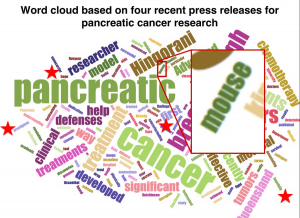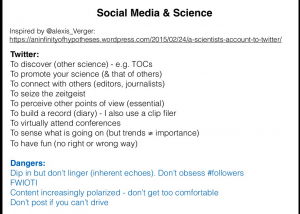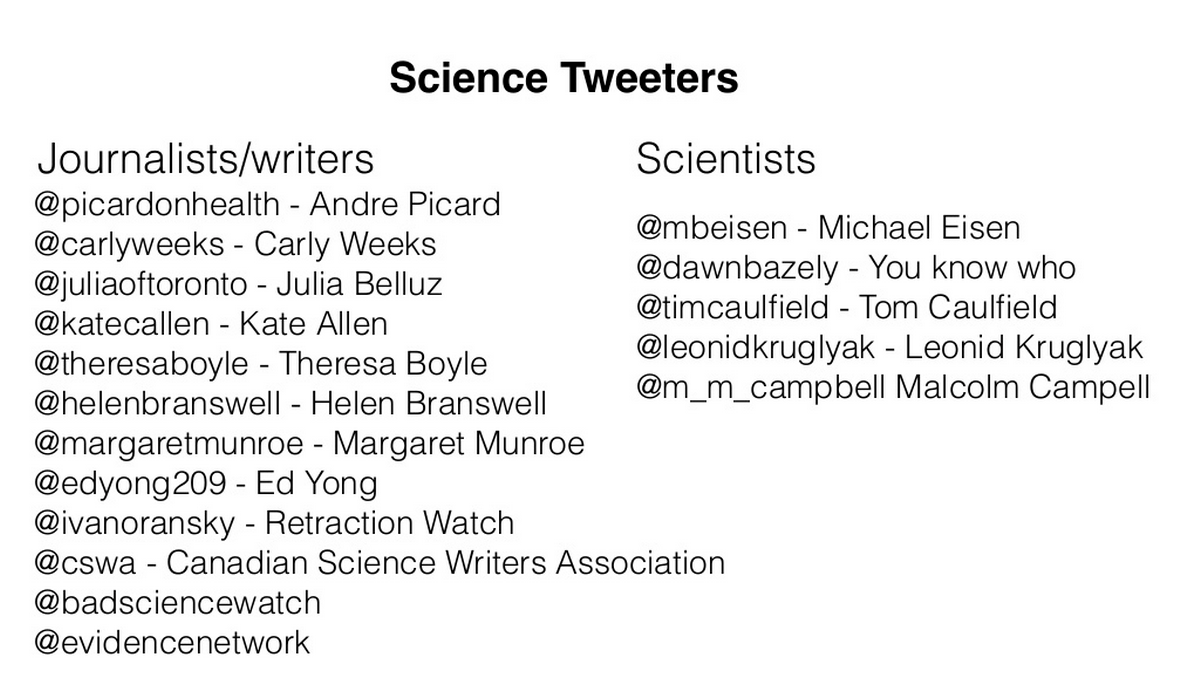Yesterday, Monday 2 March, Dr. Jim Woodgett, research director of Mount Sinai's Lunenfeld-Tanenbaum Research Institute, spoke about the issues and challenges faced by scientists, when it comes to doing effective communication of science in the public understanding of science realm.
If you’re a Canadian scientist on Twitter you will know him as @JWoodgett, and may have experienced his rapid-fire repartee, witty ripostes, and his unfortunate fondness for puns (I added this last edit in right now, on 17-2-21, Year 2 of the Covid_19 Pandemic). He recently authored a paper in Trends in Cell Biology on the need for scientists to make friends with social media.
Jim’s talk is available on slideshare. He is a fan of emojis.
1/ Gave a #scicomm talk @YorkUScience. Thanks to @dawnbazely Slides here: http://t.co/utG7uAFpGq It’s a huge #FF to many admired tweeters.
— Jim Woodgett (@jwoodgett) March 3, 2015
In this blog, I have summarized his main messages.
In the Global North, we live in a world that depends on science, technology and the scientific method. Yet, Jim pointed out that, these days, science has a credibility problem.
He asked us to consider the following questions, often asked by members of the public:
1. Is pseudoscience (fill in any stuff here, that’s not supported by peer-review) really so bad?
2. Why should we trust science?
Jim described 5 main problems that science and scientists face, when it comes to communication:
A. Science is often covered in the mainstream media in a way that trivializes it.
B. Scientists are an inaccessible elite, somewhat akin to a secret society, that uses code words and jargon.
C. Science is expensive and there are always funding pressures that need to be rebutted and costs that must be justified.
D. Scientists disagree with each other all the time, and some cheat.
E. Scientific dogma changes all the time.
Jim discussed the challenges of teaching science in K-12 (and, arguably in some undergrad courses).
- There is the gee-whiz, let’s make it fun, approach, when, in fact, science is mostly tedious, boring and repetitive.
- There is the tendency to oversimplify science.
- Lots of students segue out of science courses fairly early on.
- There is a tendency (which, I would argue is a constant struggle for us to address) towards the didactic, rather than experiential teaching of science.
Not mincing any words, Jim warned us, that we scientists often sound patronizing (I am guilty and have worked for decades to address this shortcoming) when we explain our research to the broader public (and, truth be told, even to colleagues).
In short, scientists are often our own worst enemies when it comes to doing outreach and communication.
But, this isn’t totally our fault: a lot of science communication is related to the need for publicity, as it relates to research funding and fund-raising. This kind of outreach creates a particular style of science communications and a tendency towards the “elevator pitch” style of #SciComm (again, guilty as charged).
Jim asked us to consider whether coating science in hype is ethical.
 Check out his slide of a word cloud from 4 recent pancreatic cancer research publications, and what pops out (and doesn't).
Check out his slide of a word cloud from 4 recent pancreatic cancer research publications, and what pops out (and doesn't).
Jim also illustrated how, in the MSM (mainstream media), there is often a co-association of fatigue with distrust and fallacious logic in putting things together in a simplistic way:
e.g. Monsanto is evil, therefore, GMOs are evil, therefore, it’s bad that Monsanto puts DNA in food.
Jim went on to illustrate some of the more notorious recent cases of scientific fraud, including one that resulted in the suicide of the principal investigator, in Japan.
He pointed out some of the hype that emerges from the rush to make over-reaching promises, and how this sets up ridiculous research expectations, that, in the case of medical patients, can have a poor effect on them, raising their hopes in unrealistic ways.
Jim went on to address the “we can’t afford science” critiques that pop up in the media, and the importance of countering this.
Finally, before going on to describe two recent cases of how science communication has come unstuck in the media, Jim emphasized how difficult it is to communicate how science is a process and that "Science is NEVER settled".
He suggested that the fact that science constantly hacks down its own ideas, means that it is easily critiqued and exploited by anti-science ideologies and perspectives. He discussed the emergence of “false balance” and the giving of voice to pseudoscience in the media.
The two case studies that Jim described were:
1. The Toronto Star coverage of Gardasil.
2. The recent “Alternative Cares of Medicine” conference held at Scarborough Campus of U of T.
 Jim ended with a shout out to the idea that Social Media is good for science communication and to some of the Tweeters that he follows!
Jim ended with a shout out to the idea that Social Media is good for science communication and to some of the Tweeters that he follows!
I met Jim in person, yesterday, for the first time, having interacted with him on social media for ages. Sadly, in my rush to take notes, I regret that I didn't get a selfie with him! But, maybe, my arms aren't long enough, anyway.


